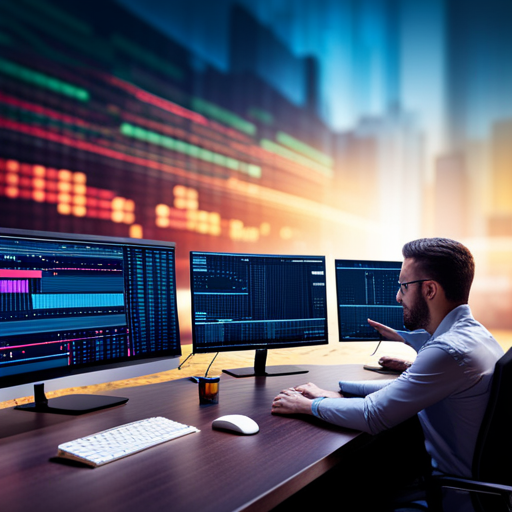Are you ready to unlock the power of computer vision?
In this guide, we will explore the top frameworks and best practices that will empower you to harness the true potential of this revolutionary technology.
Discover the secrets to implementing computer vision systems effectively and learn how this cutting-edge innovation is transforming real-world applications.
Overcome the challenges of computer vision development and stay ahead of the game by exploring future trends and innovations in this rapidly evolving field.
Get ready to revolutionize your approach to computer vision technology.
Key Takeaways
– OpenCV, TensorFlow, PyTorch, Caffe, and Keras are key frameworks for computer vision.
– Best practices for implementing computer vision systems include data preprocessing, model selection, data augmentation, hyperparameter tuning, and regularization.
– Computer vision has numerous applications in healthcare, manufacturing, retail, transportation, logistics, and other sectors.
– Challenges in computer vision development include obtaining labeled data, algorithm selection, dealing with real-world variability, optimizing for real-time performance, and continuous learning and refinement.
– Future trends and innovations in computer vision include deep learning advancements, edge computing, explainable AI, 3D computer vision, and integration with other technologies.
5 Key Frameworks for Computer Vision
@ Midjourney AI Image Prompt: /imagine prompt:Create an image showcasing the logos of OpenCV, TensorFlow, PyTorch, Caffe, and Keras, arranged in a clean grid-like pattern. Each logo should be distinct and recognizable, representing the 5 key frameworks for computer vision. –v 5.2 –ar 16:9
There are several key frameworks for computer vision that are widely used in the industry.
One of the most popular frameworks is OpenCV, which stands for Open Source Computer Vision Library. It provides a wide range of tools and functions for image and video processing, making it a versatile choice for computer vision tasks.
Another widely used framework is TensorFlow, developed by Google. It offers a comprehensive platform for building and deploying machine learning models, including those used in computer vision. TensorFlow’s high-level API, Keras, is particularly useful for beginners as it simplifies the process of building and training deep learning models.
PyTorch is another powerful framework that has gained popularity in recent years. Known for its dynamic computation graph, PyTorch provides flexibility and ease of use, making it a favorite among researchers and developers.
Additionally, Caffe is a deep learning framework that is especially suited for image classification tasks. Its focus on speed and efficiency makes it a great choice for real-time applications.
These frameworks provide a solid foundation for developing computer vision applications and are widely supported by the community, making them essential tools for any computer vision practitioner.
Best Practices for Implementing Computer Vision Systems
@ Midjourney AI Image Prompt: /imagine prompt:Create an image portraying a diverse team collaborating in a well-lit room, surrounded by whiteboards filled with meticulously outlined data flowcharts, algorithmic diagrams, and annotated images, showcasing the best practices for implementing computer vision systems. –v 5.2 –ar 16:9
When implementing computer vision systems, it’s important to follow best practices. These practices ensure that your system performs optimally and produces accurate results. Here are some key best practices to consider:
1. Data preprocessing: Before feeding your data into the computer vision system, it’s crucial to preprocess it. This includes tasks like resizing images, normalizing pixel values, and removing noise.
2. Model selection: Choose the right model architecture for your task. Consider factors like accuracy, speed, and memory requirements. Popular choices include Convolutional Neural Networks (CNNs) and Deep Neural Networks (DNNs).
3. Data augmentation: Enhance your dataset by applying random transformations like rotation, scaling, and flipping. This helps improve the model’s ability to generalize and handle variations in input data.
4. Hyperparameter tuning: Experiment with different hyperparameter values like learning rate, batch size, and optimizer to find the best combination for your specific task.
5. Regularization: Prevent overfitting by applying techniques like dropout, L1 or L2 regularization, or early stopping.
Remember, implementing computer vision systems is an iterative process. Continuously evaluate and refine your models to achieve the best results. By following these best practices, you can unlock the full potential of computer vision and build robust and accurate systems.
| Best Practices | Benefits |
|---|---|
| Data preprocessing | Improved accuracy |
| Model selection | Optimal performance |
| Data augmentation | Generalization |
| Hyperparameter tuning | Better convergence |
| Regularization | Overfitting prevention |
Following these practices will ensure that your computer vision system is efficient, accurate, and reliable. So, get started and unleash the power of computer vision!
Understanding the Power of Computer Vision in Real-World Applications
@ Midjourney AI Image Prompt: /imagine prompt:Create an image showcasing a diverse range of real-world applications of computer vision: autonomous vehicles navigating busy city streets, facial recognition in security systems, and medical imaging assisting doctors in diagnosis. –v 5.2 –ar 16:9
To fully harness the capabilities of computer vision in real-world applications, you need to understand its potential and how it can revolutionize various industries.
Computer vision, a branch of artificial intelligence, enables computers to interpret and understand visual data, just like humans do. By equipping machines with the ability to see and comprehend images or videos, computer vision opens up a world of possibilities.
In industries such as healthcare, computer vision can be used to detect diseases or abnormalities in medical images, aiding doctors in making more accurate diagnoses.
In manufacturing, computer vision can optimize quality control processes by inspecting products for defects or inconsistencies.
In retail, computer vision can enhance customer experiences through personalized recommendations or interactive displays.
Transportation and logistics can benefit from computer vision by improving object detection for autonomous vehicles or optimizing warehouse operations.
The potential applications of computer vision are vast, and its impact on various sectors is significant. By leveraging this technology, businesses can streamline processes, increase efficiency, and improve decision-making.
However, to fully harness the power of computer vision, it is essential to understand the algorithms, frameworks, and best practices associated with it. This knowledge will enable you to design and implement effective computer vision systems that deliver accurate and reliable results.
Overcoming Challenges in Computer Vision Development
@ Midjourney AI Image Prompt: /imagine prompt:Prompt: Create an image showcasing a diverse team of developers collaborating, surrounded by complex algorithms and datasets. Illustrate their determination as they overcome obstacles, symbolized by puzzle pieces falling into place within a futuristic computerized environment. –v 5.2 –ar 16:9
Developers face various challenges in the development of computer vision systems, but with proper training and experience, you can overcome these obstacles and create effective and accurate solutions.
One of the major challenges is obtaining high-quality labeled data for training. You need a large dataset with accurate annotations to train your computer vision algorithms. This requires a significant amount of time and effort to collect and label the data.
Another challenge is selecting the right algorithms and models for your specific application. There are numerous computer vision algorithms available, and choosing the right one can be overwhelming. You need to understand the strengths and limitations of each algorithm to make an informed decision.
Additionally, dealing with real-world variability can be challenging. Lighting conditions, occlusions, and variations in object appearance can affect the performance of your computer vision system. You need to account for these factors during the development and testing phases.
Lastly, optimizing your system for real-time performance can be a challenge. Computer vision algorithms can be computationally intensive, and achieving real-time performance requires efficient implementation and hardware acceleration techniques.
With dedication and persistence, you can overcome these challenges and develop powerful computer vision systems that revolutionize various industries.
Future Trends and Innovations in Computer Vision Technology
@ Midjourney AI Image Prompt: /imagine prompt:Create an image showing a futuristic cityscape with smart security systems, autonomous vehicles, and advanced facial recognition technology seamlessly integrated into everyday life, illustrating the potential future advancements in computer vision technology. –v 5.2 –ar 16:9
You can expect exciting advancements and breakthroughs in computer vision technology as it continues to evolve and shape the future of various industries. Here’s what you can look forward to:
– Enhanced object recognition: With the rapid development of deep learning algorithms, computer vision systems are becoming more accurate and efficient in identifying and classifying objects. This means improved capabilities in areas like autonomous vehicles, surveillance systems, and medical diagnostics.
– Augmented reality experiences: Computer vision technology is revolutionizing the way we interact with the digital world. With advancements in real-time tracking and depth sensing, you can expect more immersive and seamless augmented reality experiences. From gaming to interior design, computer vision will bring virtual elements into your physical environment like never before.
– AI-powered video analytics: Video surveillance is evolving beyond just monitoring and recording. Computer vision, coupled with artificial intelligence, is enabling advanced video analytics. This includes real-time anomaly detection, crowd analysis, and predictive maintenance. By leveraging computer vision technology, industries like security, retail, and manufacturing can enhance safety, optimize operations, and improve customer experiences.
These exciting advancements in computer vision technology are just the beginning. As researchers and developers continue to push the boundaries, we can expect even more innovative applications that will transform the way we live and work.
Frequently Asked Questions
How Does Computer Vision Technology Impact Industries Like Healthcare and Agriculture?
Computer vision technology impacts industries like healthcare and agriculture by improving diagnosis accuracy and efficiency in medical imaging, enabling precision farming techniques, and enhancing crop monitoring and disease detection.
What Are the Ethical Considerations in Using Computer Vision Systems?
When considering the ethical implications of using computer vision systems, it is important to address issues such as privacy, bias, and potential misuse. These considerations are crucial for responsible implementation and use of the technology.
Can Computer Vision Systems Accurately Detect and Identify Objects in Real-Time?
Yes, computer vision systems can accurately detect and identify objects in real-time. They use advanced algorithms and deep learning techniques to analyze images and make instant predictions.
What Are the Limitations of Current Computer Vision Frameworks?
Current computer vision frameworks have limitations that you should be aware of. These limitations vary, but can include issues with accuracy, scalability, and the ability to handle complex scenarios.
How Does Computer Vision Technology Contribute to Advancements in Autonomous Vehicles?
Computer vision technology contributes to advancements in autonomous vehicles by enabling them to perceive and understand their surroundings. It allows vehicles to detect objects, recognize road signs, and navigate safely, ultimately leading to improved safety and efficiency on the roads.
Conclusion
In conclusion, by utilizing the five key frameworks for computer vision and implementing best practices, you can unlock the power of this technology.
Understanding its applications in real-world scenarios and overcoming development challenges will allow you to harness its full potential.
Furthermore, staying up to date with future trends and innovations in computer vision technology will keep you at the forefront of this rapidly advancing field.
So, don’t hesitate to embrace computer vision and revolutionize your work processes.



